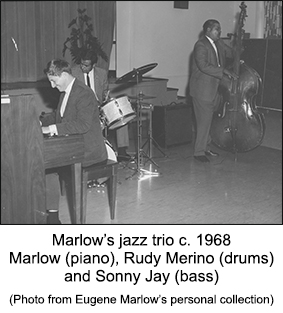There’s an old saying: “When the student is ready, the teacher appears.”
For a short time in 1967 I took a few lessons with a British-born jazz musician in Fresno, California, about an hour south of Merced and Castle AFB. He made me write out all the inversions of triads, 6th, 7th, 9th, and 13th chords in all major and minor keys—a workbook I still have. This teacher suggested I frequent a Sunday night jam session at a club on the outskirts of Fresno. It was there that I met bassist Sonny Jay.
Actually, I watched him play before I met him on the bandstand. His intonation was clear and specific. He could improvise on anything. One night I dared to get up on the bandstand. A tune was called that I had heard of but didn’t know how to play—at that time my playing and improvising skills were slightly better than meagre. Sonny recognized my predicament and he said to me (and I paraphrase): “Listen to the movement of my bass notes. I’ll lead you around the chords.” And he did. I was only slightly embarrassed, but not devastated by my paltry comping. I also knew I wanted to play with him on a more regular basis.
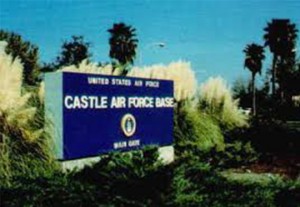 My instincts were on target. Several months later I made the painful step to disband the We Three Trio—Frank (LaGorce) was not a happy camper; Butch (Degener) didn’t seem to mind—and form a new one with Sonny on bass and drummer Rudy Merino whom Sonny had suggested. I also managed to arrange a gig at the Castle Air Force Base Officers Club where we played almost every Friday and Saturday night for over a year. We also played private parties up and down the San Joaquin Valley.
My instincts were on target. Several months later I made the painful step to disband the We Three Trio—Frank (LaGorce) was not a happy camper; Butch (Degener) didn’t seem to mind—and form a new one with Sonny on bass and drummer Rudy Merino whom Sonny had suggested. I also managed to arrange a gig at the Castle Air Force Base Officers Club where we played almost every Friday and Saturday night for over a year. We also played private parties up and down the San Joaquin Valley.
From the first moment we played together I knew I had landed in jazz Nirvana. Sonny was a virtuoso bassist—he could have improvised for half a set and no one would have said “boo”. Rudy was born with brushes in his hands and he played bossa nova rhythms—this was, after all, the mid-late sixties; “Girl From Ipanema” was de rigueur—with great taste and consistency. These two laid down a carpet of solid bass lines and rhythms that gave me room to play almost anything and it would have sounded right.
These two musicians were the best rhythm section in the San Joaquin Valley and they were playing with me! 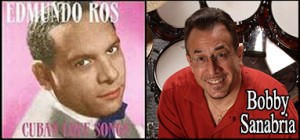 They gave me playing confidence. They put a sound in my musical memory bank that I resonate to still. They are on a continuum of my relationship to jazz ballads and swing and Latin jazz that reaches back to my listening to Latin music in London, England in the late 1940s when I heard the Edmundo Ros sextet perform—probably on early British television—to my current association with Latin jazz great Maestro Bobby Sanabria. At the same time—in the late 1940s—I listened constantly to my father’s 78 rpm recording of The Louis Jordan Band performing “Caldonia.” Both threads are linked.
They gave me playing confidence. They put a sound in my musical memory bank that I resonate to still. They are on a continuum of my relationship to jazz ballads and swing and Latin jazz that reaches back to my listening to Latin music in London, England in the late 1940s when I heard the Edmundo Ros sextet perform—probably on early British television—to my current association with Latin jazz great Maestro Bobby Sanabria. At the same time—in the late 1940s—I listened constantly to my father’s 78 rpm recording of The Louis Jordan Band performing “Caldonia.” Both threads are linked.
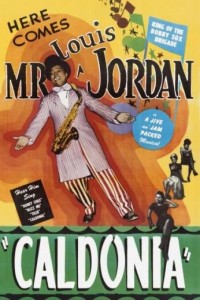 Once, during a gig break, Rudy mentioned to me that Sonny had played with the renowned Louis Jordan, the same Louis Jordan who was inducted into the Rock and Roll Hall of Fame, who has been called the “Father of Rhythm & Blues” and “the Grandfather of Rock n’ Roll,” according to Jordan’s biography on the Rock and Roll Hall of Fame and Museum website. Jordan and his Tympany Five launched 57 singles onto the R&B charts in the forties, including 18 songs that went to #1. “Caldonia” was one of those #1 songs. It is perhaps fateful that 17 years after listening to “Caldonia” in London, England as a boy I would be playing as a young man with one of the musicians who had recorded with Jordan in the early-mid-1950s.
Once, during a gig break, Rudy mentioned to me that Sonny had played with the renowned Louis Jordan, the same Louis Jordan who was inducted into the Rock and Roll Hall of Fame, who has been called the “Father of Rhythm & Blues” and “the Grandfather of Rock n’ Roll,” according to Jordan’s biography on the Rock and Roll Hall of Fame and Museum website. Jordan and his Tympany Five launched 57 singles onto the R&B charts in the forties, including 18 songs that went to #1. “Caldonia” was one of those #1 songs. It is perhaps fateful that 17 years after listening to “Caldonia” in London, England as a boy I would be playing as a young man with one of the musicians who had recorded with Jordan in the early-mid-1950s.
There’s very little on the public record about Sonny, except a mention of him in Bob Eagle and Eric S. LeBlanc’s book Blues: A Regional Experience (Praeger 2013, p. 538). Sonny was born Thurber Daniel Jay in Texas on July 25, 1917. He died in Fresno, California (where I met him) on April 12, 1993. He’s buried at Belmont Memorial Park in Fresno as Sonny Jay. This brief citation confirms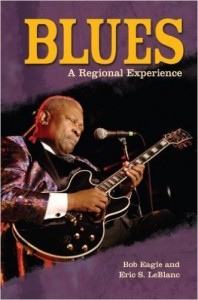 that he recorded with Louis Jordan for labels Decca, Aladdin and “X” from 1953-1955. It also mentions he was a pioneer electric bassist, although he always performed on an acoustic bass when he played in our trio. According to Fresno-based pianist Leonard M. Heifetz (no apparent relation to violin virtuoso Jascha Heifetz) Sonny had a son, Joaquin Jay, who became a lead homicide detective in Fresno. Sonny’s wife, LaFaye Jay, was an executive assistant to then California State Assemblyman, then Senator George Zenovich. Heifetz played in Fresno with Sonny in the late 1960s-early 1970s.
that he recorded with Louis Jordan for labels Decca, Aladdin and “X” from 1953-1955. It also mentions he was a pioneer electric bassist, although he always performed on an acoustic bass when he played in our trio. According to Fresno-based pianist Leonard M. Heifetz (no apparent relation to violin virtuoso Jascha Heifetz) Sonny had a son, Joaquin Jay, who became a lead homicide detective in Fresno. Sonny’s wife, LaFaye Jay, was an executive assistant to then California State Assemblyman, then Senator George Zenovich. Heifetz played in Fresno with Sonny in the late 1960s-early 1970s.
Sonny was in his early fifties when I knew him (I was in my early-mid-twenties). He was a sweet, mostly laid back man who apparently experienced a difficult marriage to a woman whose eyes for glamour and status were larger than his ability to provide it. He had a quiet manner, but when speaking of other bass players of lesser ability and skill he would say “Well, he has a bass.” I think of him often.
Sonny was African-American. South Merced-born Rudy Merino was a Chicano, or Mexican-American. Together with my British-Russian-Polish-German ancestry we were a pretty ethnically diverse small ensemble. It never occurred to me—it was still the 1960s—that we would ever experience any racism or ethnic bias—and we never did. The quality of our ensemble playing transcended any potential problems.
When I met Rudy he was in his early thirties. He was an ex-Marine. He once told me he always wanted to be a Marine after graduating from high school, but “. . .after a couple of days in the Marines, I knew I didn’t want to be in the Marines.” Rudy recently recounted one experience while in the Marines. Sometime in 1958 (he enlisted in 1956) he and other Marines were shipped out to Red Rock, Nevada. There they became, in effect, guinea pigs for an atomic bomb test. They were placed in a trench about three miles from ground zero. Rudy said he could hear the bomb blast coming: “It sounded like a train.” They all wore dark glasses and ponchos that covered their bodies. He was most concerned about becoming sterile. Fortunately, it didn’t happen.
After his stint in the Marines he went to work for Bank of America: “They heard I was a good typist,” says Merino. 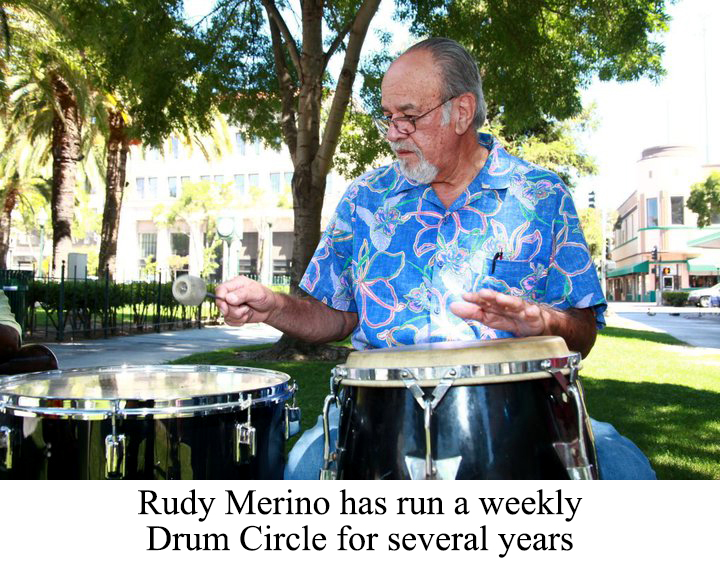 Thereafter, he went to work for Pacific Gas & Electric: a career as an associate gas engineer, according to one local newspaper article, that lasted 35 years. He married and had three sons, although, he and his first wife divorced. His second wife tragically died from brain cancer. He is happily married to his third wife, Cindy, who is a private investigator.
Thereafter, he went to work for Pacific Gas & Electric: a career as an associate gas engineer, according to one local newspaper article, that lasted 35 years. He married and had three sons, although, he and his first wife divorced. His second wife tragically died from brain cancer. He is happily married to his third wife, Cindy, who is a private investigator.
Rudy’s love of jazz extended to his one-time ownership of Rudy’s Blues and Jazz Club located on Merced’s Main Street which he and wife Cindy opened in early 2004. He gave it up, though, after 10 years. A restaurant, currently under renovation, now sits in its place. According to a 2010 article in the Merced Sun-Star in 2005 “Merino was recognized by the Merced County Arts Center for his contributions to the Merced music scene and was granted a lifetime achievement award. At the same time, then-Mayor Ellie Wooten declared June 18 Rudy Merino Day.”
At one time Rudy owned 13 drums sets. Today he has four. Even at age 77 he still gets calls for gigs. One of the major reasons: his expertise with brushes, the same musical skill I enjoyed listening to and playing with when he and Sonny enveloped me with their tasteful sounds that I can still feel to this day.
Eugene Marlow, Ph.D.
July 27, 2015
© Eugene Marlow 2015


